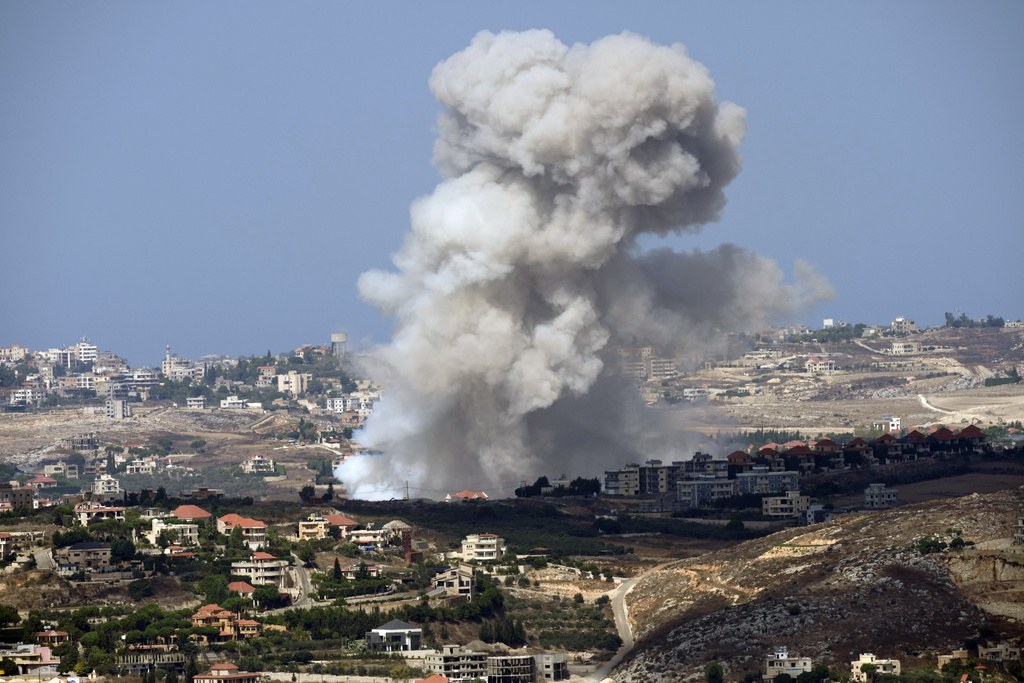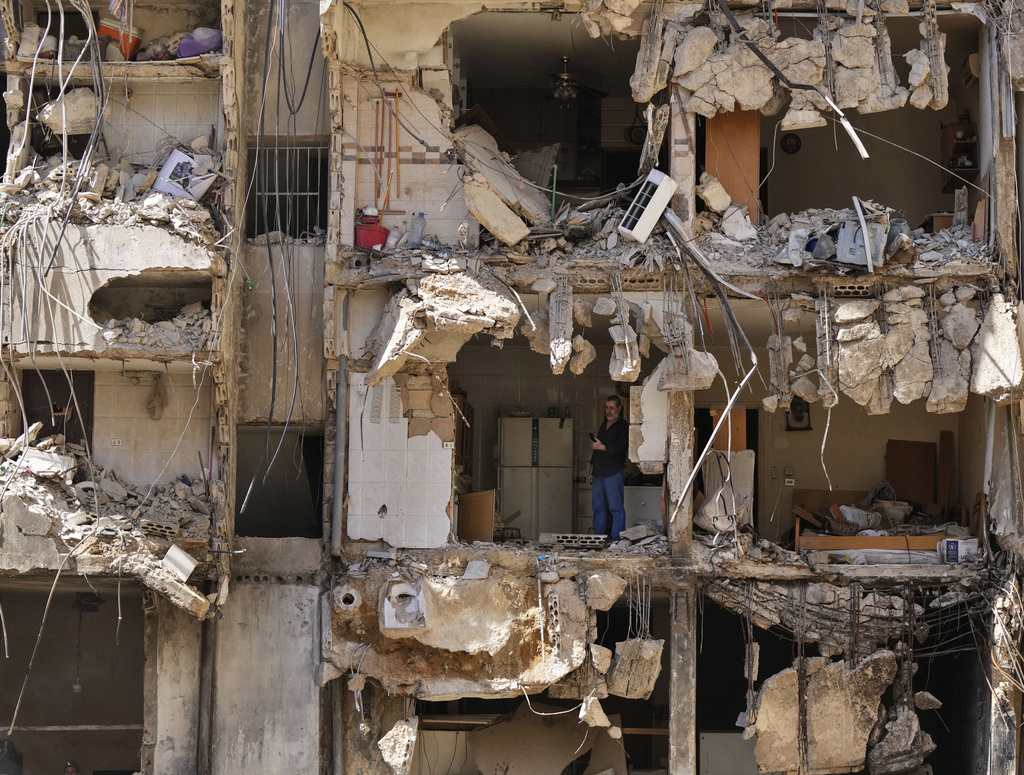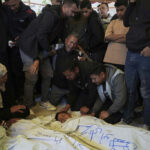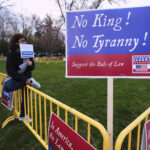Israeli Airstrikes Kill 492, Spark Largest Exodus Since 2006 War \ Newslooks \ Washington DC \ Mary Sidiqi \ Evening Edition \ Israeli airstrikes on Lebanon killed 492 people on Monday, marking the deadliest single-day assault since the 2006 Israel-Hezbollah war. Among the dead were 35 children and 58 women, as Israel expanded its campaign against Hezbollah. Thousands of Lebanese civilians fled southern regions as airstrikes targeted key Hezbollah positions. The intensifying conflict, coupled with ongoing violence in Gaza, raises fears of a broader regional war as the U.S. and allies push for diplomatic solutions.

Israel-Hezbollah Conflict Escalates: Key Points
- Death toll climbs: Israeli airstrikes killed 492 people, including women and children, in Lebanon.
- Mass evacuation: Thousands of Lebanese civilians fled southern Lebanon as Israel intensified airstrikes.
- Hezbollah retaliation: Hezbollah launched over 9,000 rockets and drones into Israel since October, with 250 on Monday.
- U.S. diplomatic efforts: The U.S. and international allies push for a cease-fire and de-escalation between Israel and Hezbollah.
- Lebanon hit hard: Strikes damaged hospitals, homes, and infrastructure, with fears of further civilian casualties.
- UN concern: The UN has suspended patrols along the Israel-Lebanon border due to the heavy exchange of fire.
Deep Look:
In what has become the deadliest escalation of violence between Israel and Hezbollah since the 2006 war, Israeli airstrikes on Lebanon on Monday resulted in 492 deaths, including 35 children and 58 women. The strikes, part of a broader Israeli military campaign against Hezbollah, have led to widespread destruction in southern and eastern Lebanon and triggered a mass exodus of civilians fleeing to Beirut. Thousands of Lebanese packed their belongings and fled their homes, creating traffic jams along the main highways, in what marks the largest movement of people since the 2006 conflict.
The strikes were part of Israel’s intensified air campaign targeting Hezbollah’s military infrastructure in southern Lebanon, which has long been a stronghold for the militant group. Israeli Prime Minister Benjamin Netanyahu issued a stern warning to Lebanese civilians in the affected areas, urging them to evacuate immediately. “Please get out of harm’s way now,” Netanyahu said in a recorded message, advising that civilians could safely return after Israel’s military operation concludes. He added that Israel would “do whatever is necessary” to neutralize the Hezbollah threat.
Rear Admiral Daniel Hagari, an Israeli military spokesperson, emphasized that the strikes were aimed at dismantling Hezbollah’s capabilities, including missile launchers, drones, and rockets hidden within residential areas. “Hezbollah has turned southern Lebanon into a war zone,” Hagari told a press conference. He noted that over 1,600 Hezbollah targets were struck on Monday alone, claiming significant damage to Hezbollah’s military infrastructure. The Israeli military has accused Hezbollah of stockpiling weapons in civilian homes and using villages in southern Lebanon as cover for launching attacks against Israel.
Since October 2022, Hezbollah has launched more than 9,000 rockets and drones at Israel, including 250 projectiles on Monday. In response, Israel has ramped up its airstrikes, with Monday’s death toll surpassing that of the devastating 2020 Beirut port explosion. The Lebanese Health Ministry reported that 1,645 people were wounded in the strikes, and hospitals in southern Lebanon and the eastern Bekaa Valley have been overwhelmed. The ministry urged hospitals to postpone non-urgent surgeries and prioritize treating those injured in the attacks.
The rapid escalation has raised fears of a broader war in the region, particularly as Israel simultaneously engages in its ongoing military campaign against Hamas in Gaza. Hezbollah, which has vowed to continue its strikes in solidarity with Hamas, launched dozens of rockets at Israeli military bases and civilian targets in retaliation for Israeli airstrikes that have killed its top commanders and dozens of fighters in recent days.
One of the most significant strikes on Monday targeted Beirut, where three Israeli missiles hit the southern neighborhood of Beir al-Abed. While Israel has provided few details about the operation, local Lebanese media reported that six people were wounded in the attack. Hezbollah’s Al-Manar TV confirmed that civilian casualties occurred, and Lebanon’s Health Minister Firass Abiad condemned the strikes, noting that hospitals and medical centers had been hit, further straining Lebanon’s already fragile health system.
Israel’s air campaign also extended to areas along Lebanon’s eastern border with Syria, where Hezbollah has a well-established presence. The Israeli military said it expanded the scope of its operations to target Hezbollah strongholds in the Bekaa Valley, where the group has operated since its founding in 1982 with support from Iran’s Revolutionary Guards.
Israeli military chief Lt. Gen. Herzi Halevi stated that Israel’s airstrikes were “proactive,” aiming to dismantle Hezbollah’s military infrastructure built up over the past two decades. Halevi also indicated that Israel is preparing for “the next phases” of its operation against Hezbollah, suggesting the possibility of further escalations, including a ground invasion. Halevi stressed that Israel’s goal is to ensure that displaced Israeli civilians in northern regions can return to their homes safely, signaling a prolonged military campaign until Hezbollah’s capabilities are significantly reduced.
The ongoing conflict has also had severe repercussions for Lebanese civilians, many of whom have been caught in the crossfire. Schools and universities across much of Lebanon have been closed, and the government is working to prepare emergency shelters for the thousands of displaced people now pouring into Beirut and other safer regions. One strike reached as far as Byblos, a town more than 80 miles from the Israeli border, illustrating the widespread reach of the air campaign.
In response to the escalating violence, U.S. and international diplomats have intensified efforts to broker a cease-fire between Israel and Hezbollah. A senior U.S. State Department official revealed that the U.S. is developing “concrete ideas” to de-escalate tensions, which will be presented to allies at the upcoming U.N. General Assembly. Although the details of these proposals have not been disclosed, the official emphasized the urgency of finding a diplomatic solution to avoid a full-scale regional war. White House Press Secretary Karine Jean-Pierre reiterated the Biden administration’s concerns over the intensifying conflict, stating that resolving the situation “quickly and diplomatically” is in everyone’s best interest.
U.N. peacekeepers stationed along the Israel-Lebanon border have halted patrols and are staying in their bases due to the “volume of exchange of fire,” according to U.N. spokesperson Stéphane Dujarric. U.N. Secretary-General António Guterres expressed alarm over the rising civilian death toll and the risk of the conflict spiraling out of control.
Despite international efforts to prevent an all-out war, Hezbollah has continued its rocket and drone attacks on Israeli military and civilian targets. The militant group stated that it would maintain its attacks until a cease-fire is reached in Gaza, where Israel has been conducting a parallel military campaign against Hamas. Hezbollah’s strikes have been in response to Israel’s October 7 airstrikes, which killed a senior Hezbollah commander and over a dozen of its fighters, along with dozens of civilians, in a Beirut suburb.
As both sides intensify their attacks, the conflict shows no signs of abating, with growing concerns that the situation could spiral into a prolonged and even more deadly war. Hezbollah’s alliance with Hamas, both backed by Iran, has complicated efforts to broker a peace deal, as Hezbollah has repeatedly linked its strikes on Israel to the ongoing conflict in Gaza.
For now, thousands of Lebanese civilians remain displaced, caught between the deadly crossfire of airstrikes, rocket fire, and escalating military operations. The conflict’s human toll continues to rise, with both Hezbollah and Israel showing little interest in stepping back from their military campaigns, despite the risks of wider regional instability.







